Vietnam is known for the long-lasting cultural values as well as the traditional construction and defense of the nation. In addition to intangible cultural heritages such as festivals, folk games, performing arts, worship etc., Vietnam is also famous for its beautiful and sacred religious sites, some of them were recognized as the World Heritage Sites. From temples and pagodas with architecture of classical or modern style to mountaintop monasteries, these amazing destinations will meet your belief. Here is the list of 15 most famous temples to visit for a spiritual journey in Vietnam.
Temples in Northern Vietnam
The One Pillar Pagoda (Chua Mot Cot) – Hanoi
This Buddhist temple is a significant monument and a historic symbol of Hanoi capital, with its long ancient history and cultural and spiritual values. It is located on Doi Can Street, Ba Dinh District, Hanoi. This is one of the most familiar and famous temples in Vietnam.
One Pillar Pagoda was built by Emperor Ly Thai Tong from 1028 to 1054. In 1106, the temple has an enlargement and renovation by Emperor Ly Nhan Tong and became a large architectural complex. In 1109, the King attempted to erect the largest bell in the country; however, the bell was too big and heavy that could not be installed. Instead, people moved it into the countryside at a nearby farmland adjacent to Nhat Tru Temple. It has a unique structure with its full strength based on a cylindrical body carrying 8 wooden wings, in the shape of a blooming lotus. This is one of the most famous tourist attractions that cannot be missed on a trip to Vietnam.
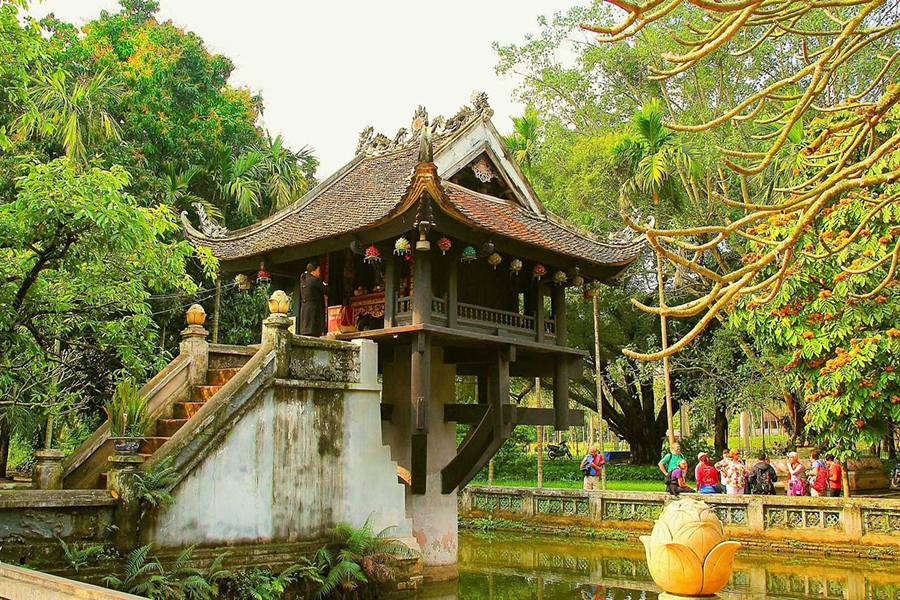
One Pillar Pagoda – Hanoi
Besides, tourists can combine admiring this site with visiting the Temple of Literature and the Ho Chi Minh Mausoleum on the same day of Hanoi city tour, since these destinations are not too far apart.
The Perfume Pagoda (Danh Thang Chua Huong) – Hanoi
This site is located at the centre of Huong Tich Cave in Huong Son Commune, My Duc District, Hanoi. In fact, the Perfume Pagoda or Huong Son is a vast cultural – religious complex of the capital of Vietnam. It includes dozens of Buddhist temples, several temples to the Gods, communal houses, and agricultural beliefs. The centre of this complex is the Perfume Temple, or the Inner Pagoda. At the current time, there is a stele at the temple that dates the building of the stone steps and Kim Dung shrine in 1686, during the reign of Le Hy Tong.
This is not only one of the most famous temples in Vietnam, the Vietnamese pride of spiritual cultural tourism to international friends, but also an educational address for history – culture exchange.
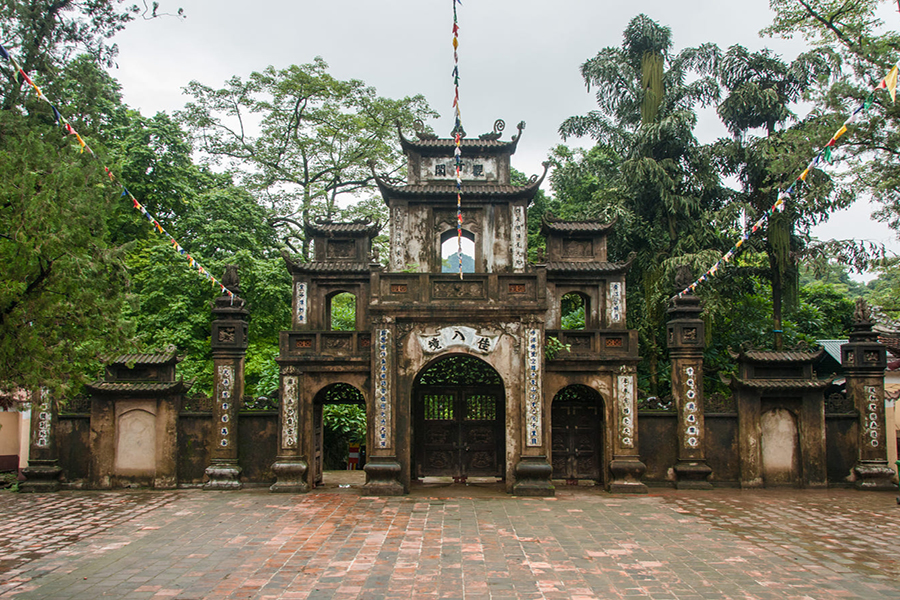
Perfume Pagoda – Hanoi
The Tran Quoc Pagoda (Chua Tran Quoc) – Hanoi
This site has its location on Thanh Nien Street, on a peninsula on the vast West Lake, in the heart of Hanoi capital. Tran Quoc Pagoda is one of the oldest temples in Vietnam with 1,500 years old. It had an original build in the 6th century, during the reign of Emperor Ly Nam De (from 544 to 548). The temple consists of 3 main buildings: the front house facing toward the street, the house for burning incense and the upper palace. The temple grounds are prominent with a 15-meter high and lotus-shaped stupa, built in 1998 with 11 floors.
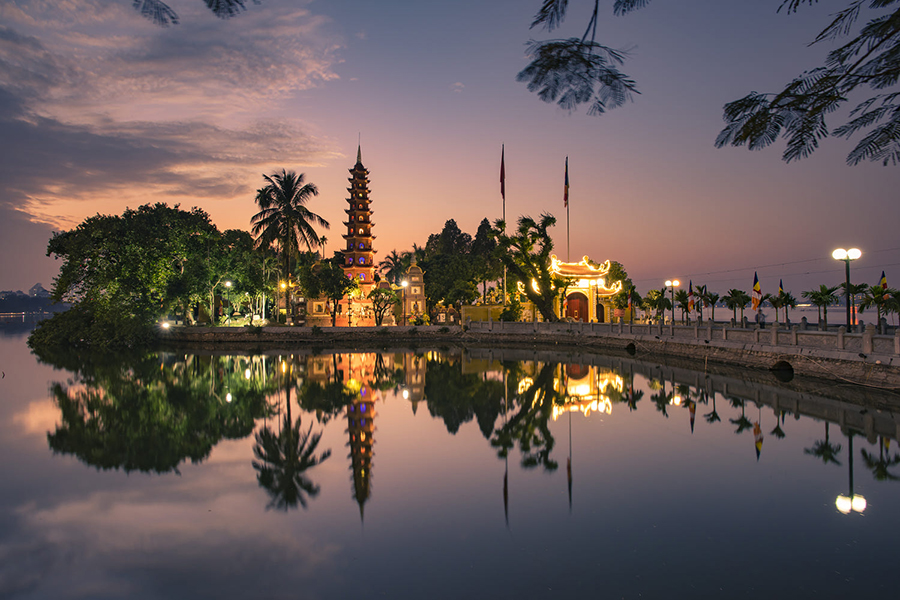
Tran Quoc Pagoda – Hanoi, Top 20 most beautiful Buddhist temples in the world
Tran Quoc pagoda has been listed 9th among the top 20 most beautiful Buddhist temples voted by the US magazine National Geographic and one of the most famous temples in Vietnam. Earlier, in 2017, Wanderlust – U.K. travel magazine, also listed Tran Quoc pagoda one of top 10 incredibly beautiful pagodas.
The Tran Temple (Den Tran) – Nam Dinh
This temple is in Tuc Mac Hamlet, Loc Vuong Commune out of Nam Dinh Citadel. The site worships 14 Kings of Tran dynasty who ruled Vietnam about 9 centuries ago. The legend goes it that in 1239, Kinh Tran ordered Phung Ta Chu to oversee the construction of a palace in the area. Te Trac, a contemporary person, described this palace: “Tide surrounds the palace, flavour of flowers pervades the air, many beautifully decorated boats come back and forth, all look like a fairyland”. It consists of Thien Truong – the upper temple and Co Trach – the lower temple that locate close to each other.
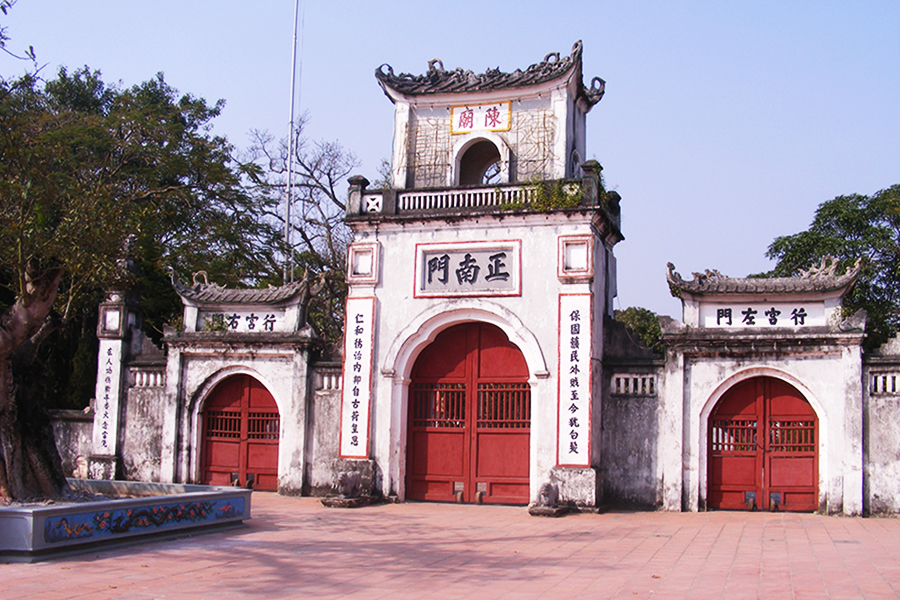
Tran Temple – Nam Dinh
Tran Temple is famous for an annual big ceremony – Khai An Den Tran Festival. It takes place on the night of the 14th day of the 1st lunar month in lunar new year and attracts thousands of visitors from all cities and provinces in the country. There are a lot of cultural activities on this occasion such as weightlifting, dragon and tiger dances, and chess competition. Rituals at the Tran Temple and relic site honor a triumphant period in Vietnam’s history and encourage a spirit of patriotism.
The Phu Day Relics Complex (Phu Day) – Nam Dinh
Phu Day is a relics complex of Vietnamese traditional and architectural beliefs and the heartland of the Mother Goddess worship. The site spreads over Kim Thai Commune, Vu Ban District, Nam Dinh Province. It locates near the highway 10, highway 37B and highway 38B from Nam Dinh to Ninh Binh City.
Phu Day means “the big temple in Ke Day village”. This sacred complex had its original build and a very high value on the level of artistic architecture of late 19th century and early 20th century. Phu Day consists of 2 main sites: Phu Tien Huong and Phu Van Cat, about 2km far from each other. Both of them worship Princess Lieu Hanh – one of The Four Immortals of Vietnam and a leading figure in the Mother Goddess cult Đạo Mẫu.
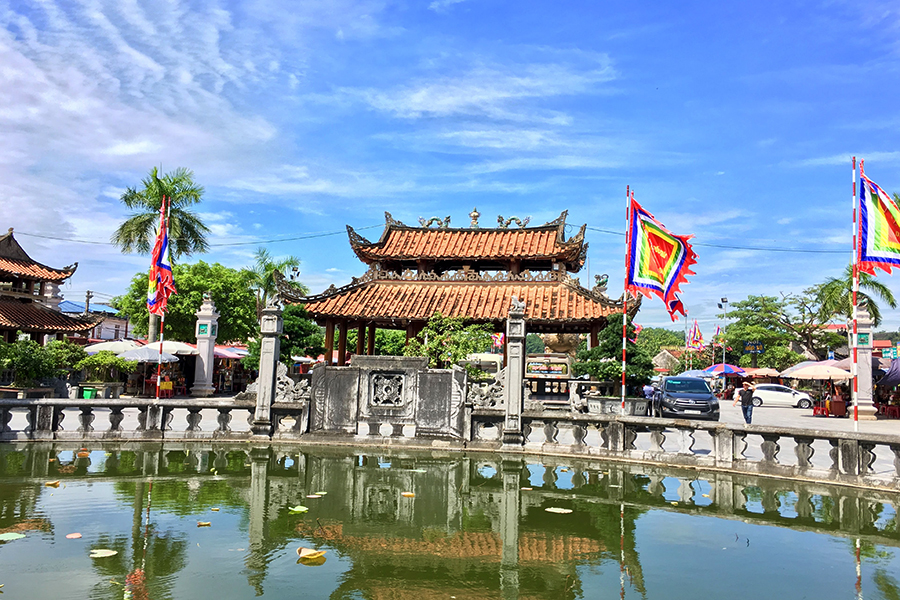
Phu Day – Nam Dinh
In 2016, UNESCO recognized Vietnam’s traditional practice of “Tho Mau Tam Phu” (Worship of Mother Goddesses) in Phu Day as an Intangible Cultural Heritage of Humanity. Phu Day Festival, a famous festival opened at the Phu Day Temple of Nam Dinh, takes place annually on the 17th of April, the third day of the third lunar month.
The Bai Dinh Pagoda (Chua Bai Dinh) – Ninh Binh
This Buddhist temple belongs to the Bai Dinh Temple Spiritual and Cultural Complex, located on Bai Dinh Mountain and nestled in a quiet forest in Gia Vien District, Ninh Binh Province. The construction of the pagoda was started in 2003 and finished in 2010. Nowadays, it covers a large area of 700 hectare. The compound has the original old temple and a newly created larger one. This is the largest complex of Buddhist temples in Vietnam and a popular sacred place for Buddhist pilgrims.
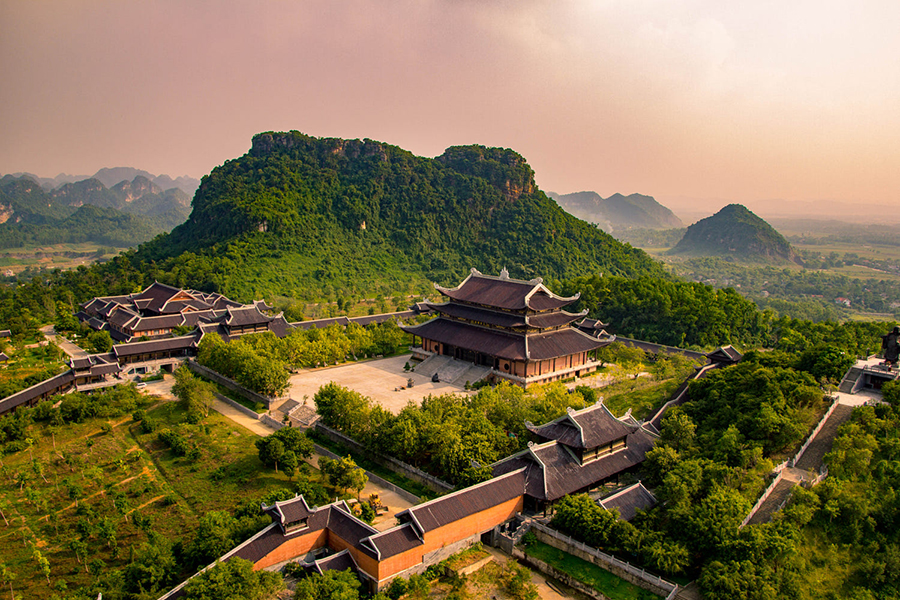
Bai Dinh Pagoda – Ninh Binh
The Hung Temple (Den Hung) – Phu Tho
This temple is located on Nghia Linh Mountain, Co Tich Village, Hy Cuong Commune, Phong Chau District, Phu Tho Province. Hung Temple is a historical complex of several temples that worship the legendary Hung Kings, has a majestic architecture construction of the 15th century.
The Ancestral Anniversary Festival of the Hung Kings, one of the largest ceremonies in the country, has been recognized by UNESCO as the Intangible Cultural Heritage of Humanity in 2012. It takes place at the beginning of the third lunar month for about one week. There are millions of people converge on Hung Temple annually to commemorate their ancestors and pray for the best.
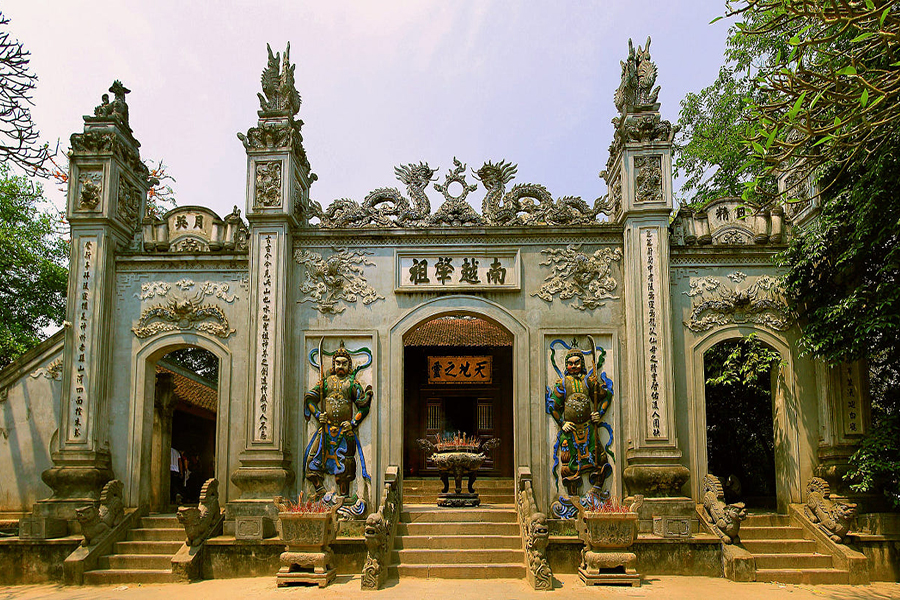
Hung Temple – Phu Tho
The Yen Tu – Quang Ninh
The Complex of Yen Tu Monuments and Landscape is located on Yen Tu Street, on the Dong Trieu range, at the intersection of two provinces: Quang Ninh and Bac Giang. The heritage site is mostly situated on a mountainous region which is about 600m above sea level. With its peak at 1,068m above sea level, Yen Tu is famous for its beautiful natural landscape and cultural heritage, also known as the ancestral land of Truc Lam Zen Buddhism in Vietnam.
Yen Tu was considered “the fourth blessing land of Giao Chau”. It was first built by King Tran Nhan Tong who reigned from 1279 to 1293. A lot of Vietnamese Buddhists have chosen the place for prayer and for religious practice because of its mystic beauty covered in cloud and sacredness. Especially, this mountain is also home to the statue of An Ky Sinh. This person came here to practise and reached the peak of his way in Buddhism.
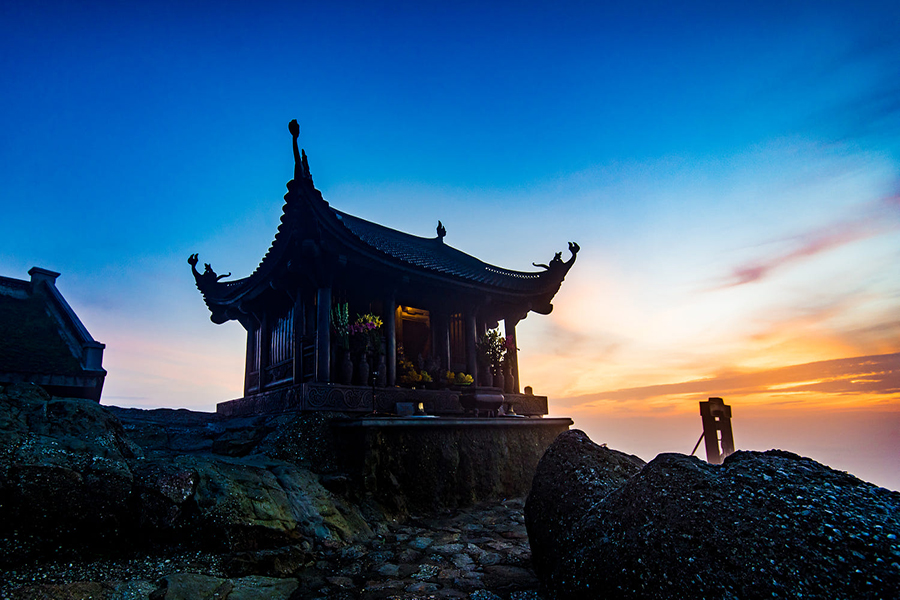
Yen Tu – Quang Ninh
Temples in Central Vietnam
The Thien Mu Pagoda (Chua Thien Mu) – Hue
The Pagoda of the Celestial Lady is a historic temple in the former Imperial Capital City of Hue and the highest religious site in Vietnam. It is also one of the most famous temples in Vietnam. Thien Mu Pagoda sits on the Ha Khe Hill and on the northern bank of the poetic Perfume River, about 5km from the Citadel of Hue. This is familiar in many traditional folk songs that have made a lot of hearts sobbing.
It was built in 1601 by Nguyen Hoang, in a legend with an old lady known as “Thien Mu” (literally “celestial lady”), dressed in a red and blue sitting at the site. She foretold that a lord would come and erect a pagoda on the hill to pray for the country’s prosperity; then vanished.
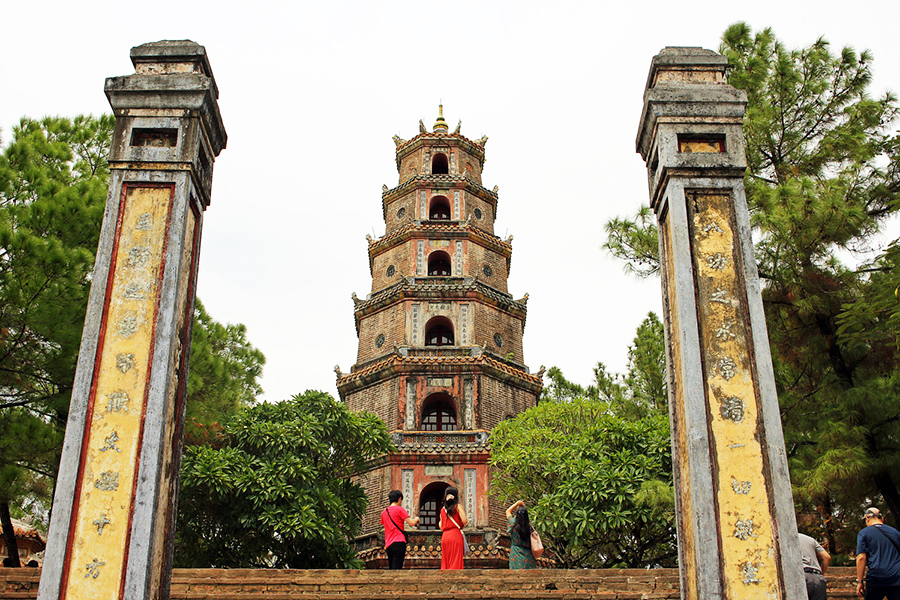
Thien Mu Pagoda – Hue
The Linh Ung-Bai But Pagoda (Chua Linh Ung) – Danang
Located on Hoang Sa Street at Son Tra Peninsula, Linh Ung-Bai But Pagoda is one of three pagodas with the same name forming a sacred triangle in the city of Danang. It was first built in 2004 and officially inaugurated in 2010. Legend has it that during Ming Mang Emperor time, on an early morning, some fishermen found a small Buddhist statue emerging from the sands. They received the statue and created a small temple to pray. Then, this land had its name of Bai But (the land of Budda). From that moment on, the land was very peaceful and the fishermen had a very good life.
Linh Ung-Bai But pagoda has an description as “a meeting place of heaven and Earth’s sacred air and people’s heart” by Lonely Planet – a large travel guide book publisher. This site has a 67m tall Guanyin Statue, the tallest in Vietnam to date.
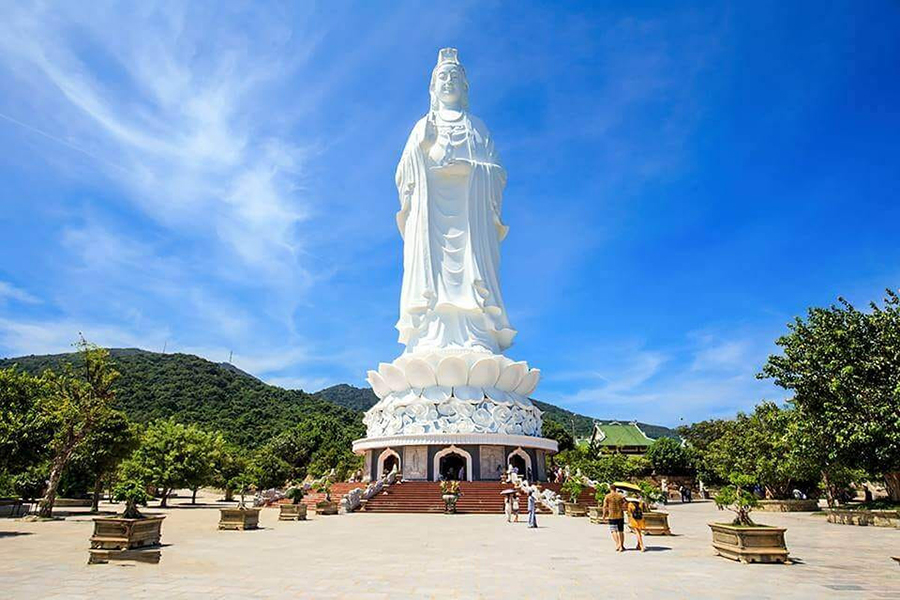
Linh Ung-Bai But Pagoda – Danang
The pagoda also has its own unique and beautiful landscape with mountains behind, ocean in the front and breath-taking view out of marvelous scenery. Tourists coming to Danang can see this pagoda from every place in the city.
The Truc Lam Zen Monastery (Thien Vien Truc Lam) – Da Lat
Truc Lam is one of the 3 biggest monasteries in Vietnam. It is located 5km from the Da Lat city center, on Phung Hoang Hill near Tuyen Lam Lake. The place has a lot of pine forests around with comfortable fresh cool air. Access to this site requires passing Tuyen Lam Lake and 222 steps crossed the triple gated entrance to enter the main courtyard of the temple.
It was opened in 1994 with its public area at about 1300m above sea level. At present, there are approximately 100 monks and nuns practicing in the private religious area at the temple.
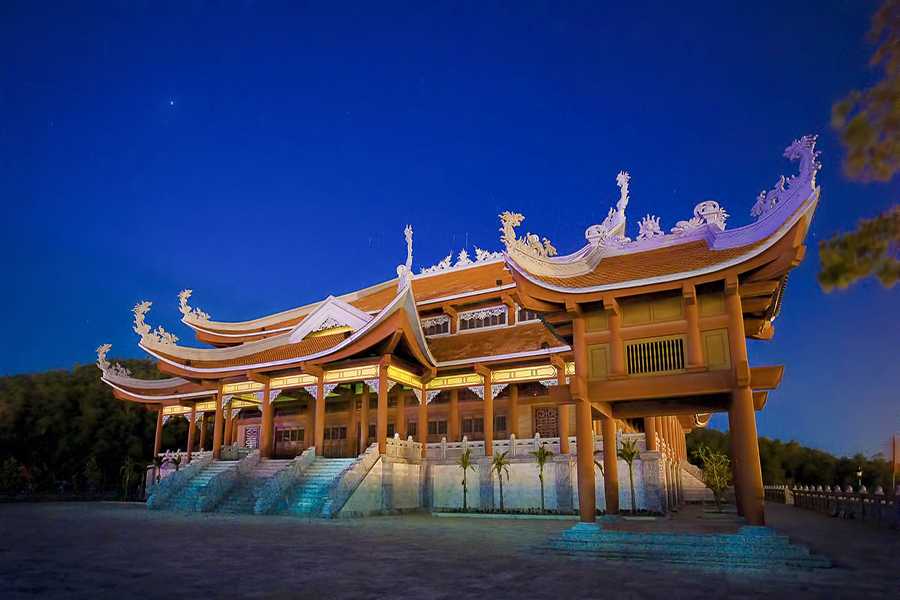
Truc Lam Zen Monastery – Da Lat
Temples in Southern Vietnam
The Black Virgin Mountain (Nui Ba Den) – Tay Ninh
This is the tallest mountain in Southeast Asia. It is also a famous spiritual tourist destination and the symbol of the land and people in Tay Ninh province. Black Virgin Mountain has a location on Thanh Tan Street, halfway up Ba Den Mountain with the height of 986 m. The temple has existed for more than 300 years. At first, it was only a small temple then under a construction as today. The main deity worshiped on the mountain is Ba Den, also known as Linh Son Thanh Mau. According to Vietnamese myth, this mountain was home to Ba Den, a local deity of Khmer.
Leading to the pagoda is a 1,500-step path, with a surround of rocks hill and luxuriant forest trees on both sides. From the foot of the mountain, it takes more than an hour to reach the temple. It is located at an altitude of more than 200 m. There is cable cars service for tourists to admire the landscape of mountains or fields extends to Dau Tieng lake below.
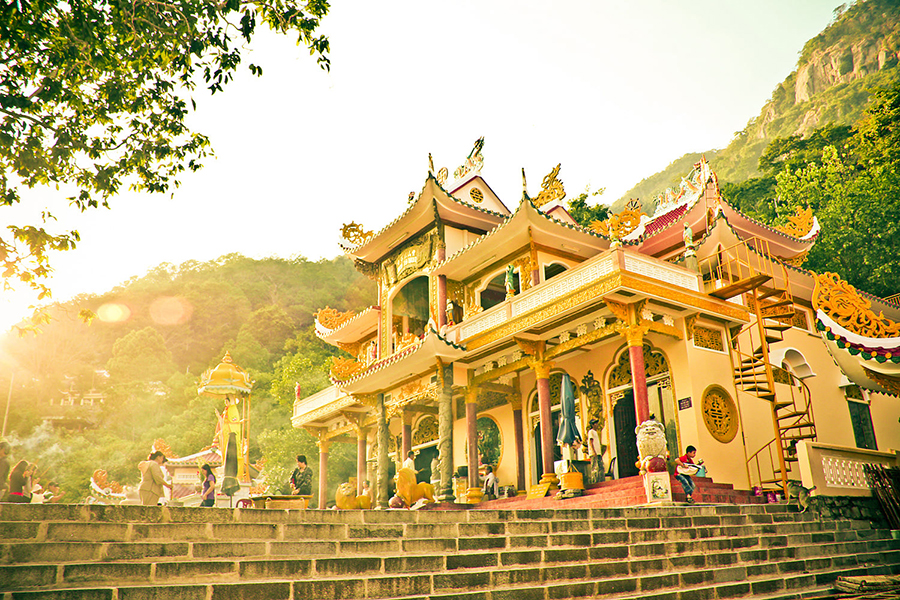
Black Virgin Mountain – Tay Ninh
The Ba Chua Xu Temple (Mieu Ba Chua Xu) – An Giang
This has another name as The Holy Mother of the Realm Temple and worships Ba Chua Xu – one of Mother Goddesses in Vietnam. It is located on the foot of Sam Mountain of Chau Doc Town, An Giang Province. This mountain lies near the border with Cambodia. This temple has the layout like the writing of the word country in Chinese, the shape of the blooming lotus, three layers of blue tiles roof. It is a large area with the main hall, the guest house and the East and West Corridors.
This temple has attracted millions of visitors to come and worship, especially during the Worship Ceremony, also known as Ba Chua Xu Temple Festival, which takes place every 23rd to 27th of April in lunar calendar.
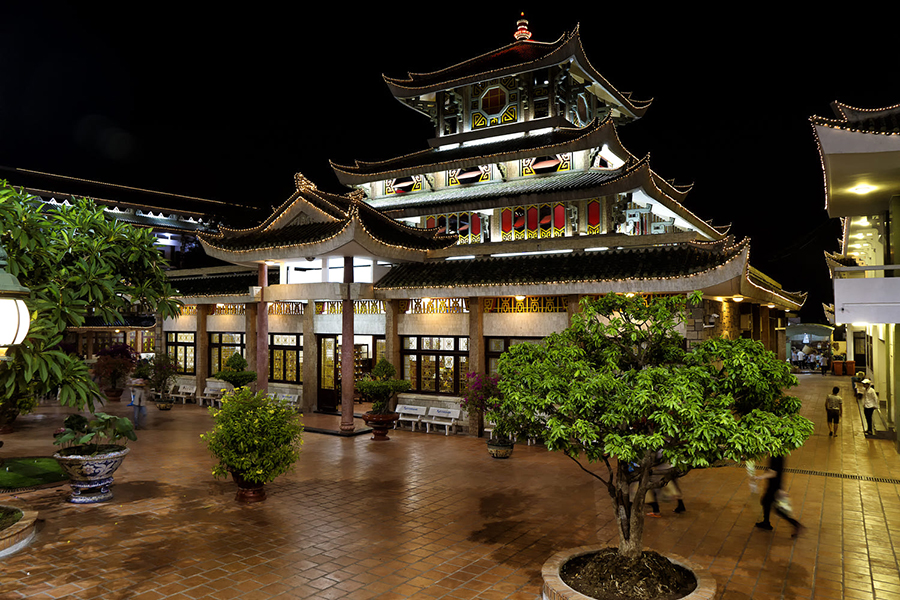
Ba Chua Xu Temple – An Giang
The Vinh Nghiem Pagoda (Chua Vinh Nghiem) – Ho Chi Minh City
This 7-storey and 40m high tower is located at No. 339, Nam Ky Khoi Nghia Street, Ward 7, District 3, Ho Chi Minh City. This is the first pagoda in Vietnam has a design of Vietnamese traditional architecture style. The construction of Vinh Nghiem Pagoda was started in 1964 and completed in 1971. In addition, there is innermost quarter Phuong Truong in the temple grounds. This pagoda also includes an L-shaped row of houses covering a lotus pond for cross travelers to rest. This belongs to most famous temples in Vietnam and one of the typical works of Vietnamese Buddhist architecture in the 20th century.
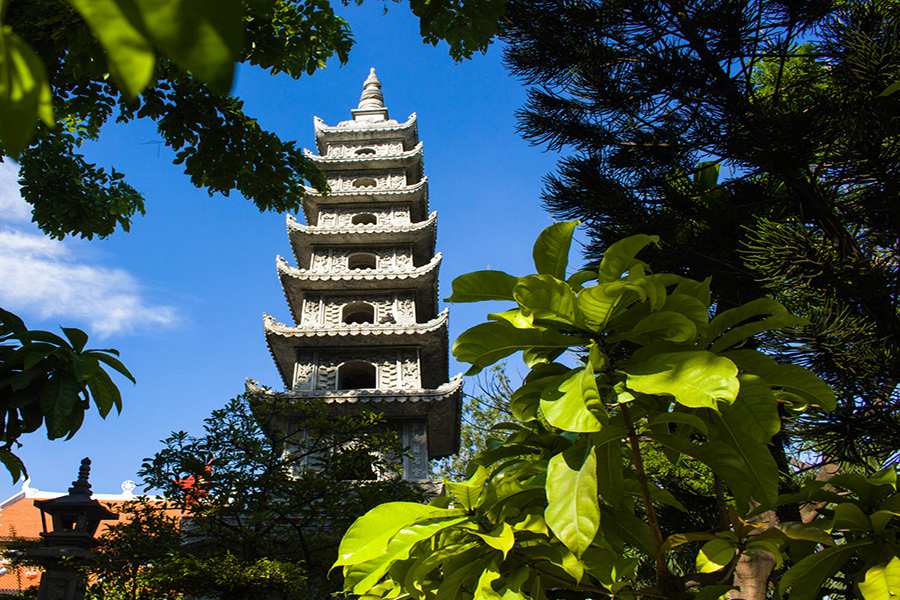
Vinh Nghiem Pagoda – Ho Chi Minh City
The Buu Long Pagoda (Chua Buu Long) – Ho Chi Minh City
Together with the Tran Quoc Pagoda, Buu Long Temple is also on the list of the 20 most beautiful temples in the world. It is located at No. 81, Nguyen Xien Street, District 9, Ho Chi Minh City; on the bank of the Dong Nai river. It takes visitors 45 minutes from the east of Ho Chi Minh City to arrive at this site, about 20km far apart.
Buu Long Pagoda was first built in 1942. In 2007, this temple received investment in construction and restoration, becoming a typical architectural work. It has the combination of the architectural elite of Nguyen Dynasty and Southeast Asian culture. The riverside also features characteristics of the Nam Tong Zen sect, intricately carved dragons. It owns a turquoise lake reflecting white walls and golden tower as well.
Especially in this peaceful pagoda, tourists will have a chance to admire Gotama Cetiya Stupa. This is the main stupa in the temple with the largest scale in Vietnam. It is 56 m high and consists of 4 surrounding towers. This place takes white as the main color, combined with the brilliant gold color. This is a must-visit destination on a trip to Ho Chi Minh City.
One thing you need to know when visiting this pagoda is that you are not allowed to burn candles or incense as in other temples, because this place worships only the Buddha.
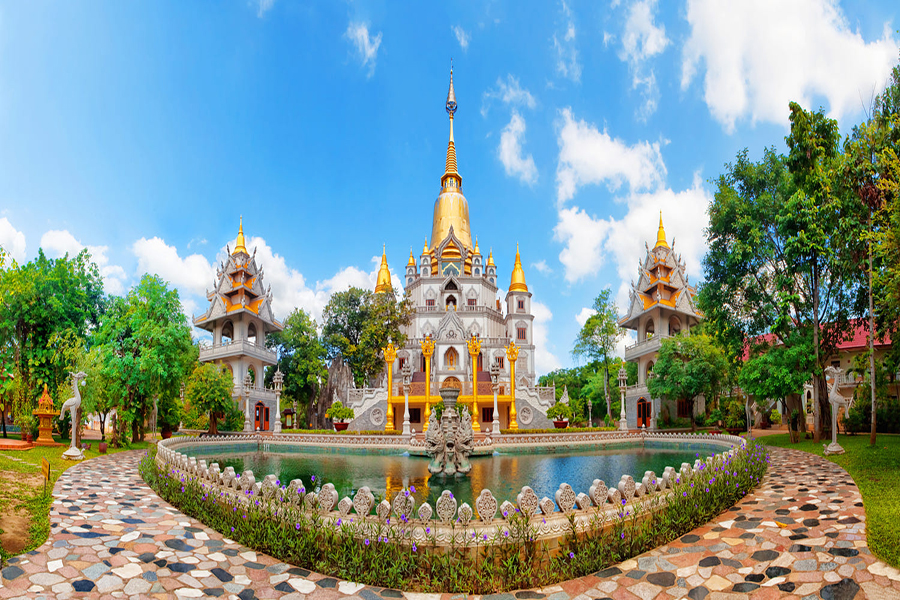
Buu Long Pagoda – Ho Chi Minh City, Top 20 most beautiful Buddhist temples in the world
Some Notes, Dos and Don’ts When Visiting Temples in Vietnam
Dos
- Wear polite clothes when entering temples, monasteries: Do not wear shorts, sleeveless T-shirts when entering the sacred religious areas in Vietnam. This rule applies to both women and men. Women must not wear skirts that are shorter than their knees, leggings, penetration clothing or exposed shoulders. If you can’t return to change clothes, you can also buy or rent suitable clothes around. Always carrying large scarves is also the solution that many travelers choose to make.
- Keep silent: When entering religious buildings, visitors should avoid playing around, shouting or teasing each other.
- Pay attention to the feet: When sitting on the ground at the temples, you also need to pay attention not to spread your legs and not point your feet towards the Buddha or the stupas.
- Besides, visitors should avoid stepping on the monks’ silhouettes while they are standing, especially the head, as this is considered impolite act.
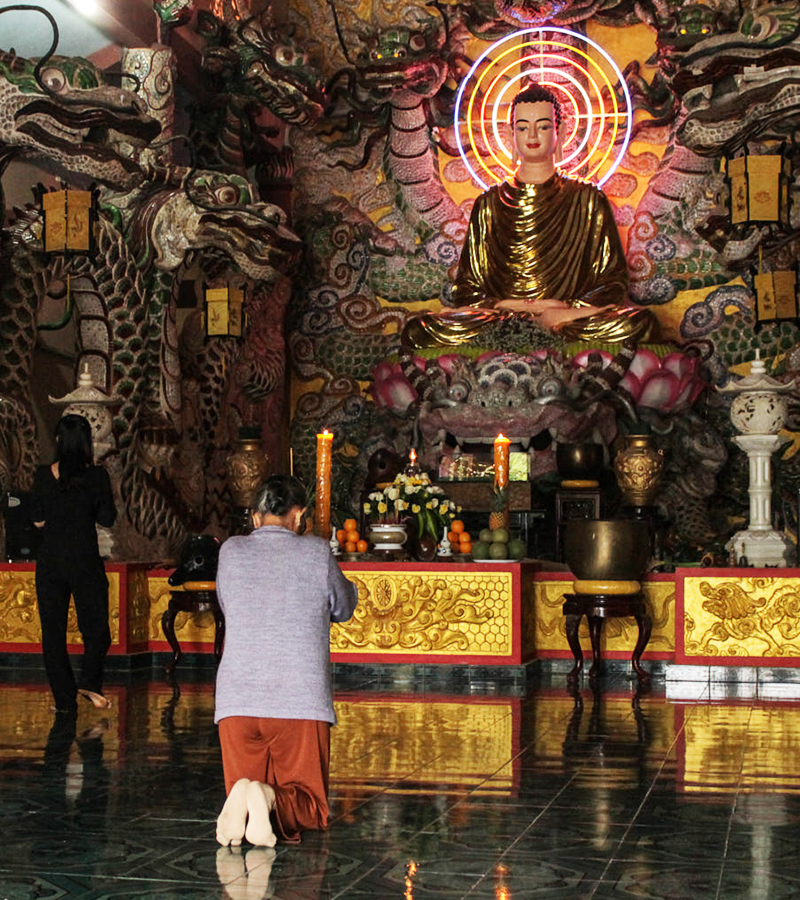
A woman praying to Buddha in Da Lat, Vietnam
Don’ts
- Show excessive affection: Religious buildings are places where rituals and expressions of devotion are performed, so you are not allowed to show excessive affection, such as cuddling, teasing, or kissing, even on the cheek. Fisting is acceptable, but it is best to avoid it.
- Disturb others when taking photos: Some temples require visitors to pay a fee if they want to take photos, some do not allow shooting to avoid disturbing the sacred atmosphere. Therefore, you should pay attention to the signs to know whether or not to take photos. In addition, visitors should avoid posing with temples or Buddha statues, not relying on or using Buddha statues as props. Monks don’t like to be photographed, if you want, you should ask permission first.
- Disturb someone who is praying or meditating: When you see a person praying or meditating, you should avoid talking loudly or laughing when approaching, nor should you pass in front of them or touch them.
- Arbitrarily sneeze nose, spitting, … around the Buddhas.
- Laugh, speak loudly: You can be loud or noisy in some public places like the market or the beach. But if you talk too loudly, causing disorder in sacred places will be considered impolite. When entering temples, pagodas or churches, remember to turn off radio equipment such as speakers and radios. Speak properly following the general rules of each place.
- Walk around: Each temple has its own space restricting people from entering and leaving. It can be a private living place or a place of worship. Visitors absolutely do not “cross the fence” if there is a ban sign. Some larger places such as citadel and mausoleum will have a sightseeing map, you should only follow the directions included in the map or the guide. Do not be curious or go beyond the allowed limit.
- Petty theft: Absolutely do not take anything in the sights. Some famous objects in the monuments also limit visitors to touch to avoid abrasion. You should carefully read the rules or notes while visiting each destination.
Notes:
- If you go to the temple, remember to enter by the right gate and exit by the left gate. The middle gate is for monks only, for academic purposes on important occasions.
- Places such as museums, temples, shrines, churches often limit filming, taking pictures. You should not use the flash here.
- The offering should be done in the right way. Therefore, you should not arbitrarily stuff money everywhere.
- When walking, do not cut across the faces of people kneeling.
- No smoking, carrying sticks, weapons in these places.

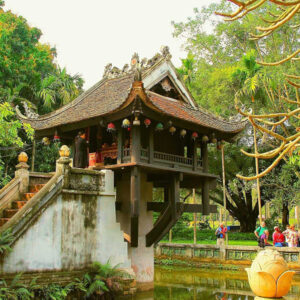


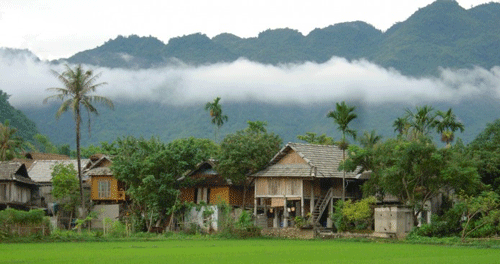


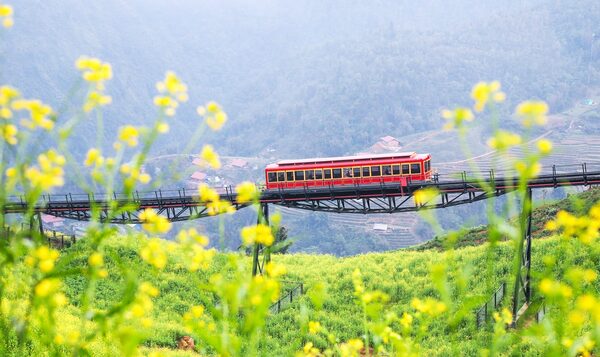

How can i book a spiritual tour? Thank you.
Please send us your inquiries to service@vietnamparadisetravel.com or via contacts on our website
Dear Swan,
Thank you for your comment. I am thrilled to know that our article helps provide you useful information about some notes when entering temples in Vietnam. If you have a plan for take a spiritual trip to Vietnam, please do hot hesitate to contact us.
Regards,
Bich Ngoc
Throw back time when I first visited Vietnam, I entered a temple right at the centre gate and now I know it was unappropriated. Thanks a lot for this helpful and informative article! Would you mind if I share it?
Thank you for your comments
You are welcome to share our articles
I’m a researcher of Asian temples and pagodas, in this article I found some picturesque and ancient temples, would love to visit them in near future.
Thank you so much for sharing this post.
Dear Frank,
Thank you for your comment. We are so glad that this article helped provide you useful information about temples and pagodas in Vietnam. If you have a plan to take a spiritual trip to Vietnam, please do not hesitate to contact us.
Regards,
Bich Ngoc
These temples are just amazing! I can’t wait to visit every single one of it next year.
Dear Ms. McKenzie,
Thank you for your comment. We are thrilled to know that you are interested in taking a spiritual trip to our country next year. It’s our mission and pride to introduce to friends all over the world the historical and cultural values of our heritages that we have been conserving.
If you have a plan to visit our country next year, please do not hesitate to contact us.
Hope to see you in our country soon!
Regards,
Bich Ngoc
I am an enthusiasist to Ancient Places especially sacred pagodas in Southeast Asia. These destinations would definitely be my first to come when iam in Vietnam next year! thanks a lot for the informative article 😀
Dear Karen,
Thank you for your comment. Nowadays, spiritual tourism is becoming more and more popular all around the world. In Vietnam, this kind of travel has become an indispensable part of people’s life for such a long time; especially in the context of modern-day development, when most of people are getting in a hurry at hustle and bustle cities. Mencius had a claim that “Human nature is good”. In my opinion, it is such a great thing that people had a positive religious belief.
I am so glad that this article helped provide useful information to you. If you are interested in sacred sites in Vietnam and Southeast Asia, do not hesitate to contact us for a spiritual trip to our country. It is our pleasure to express the pride of our long-lasting history and culture as well as introduce these heritages to friends all over the world.
Regards,
Bich Ngoc